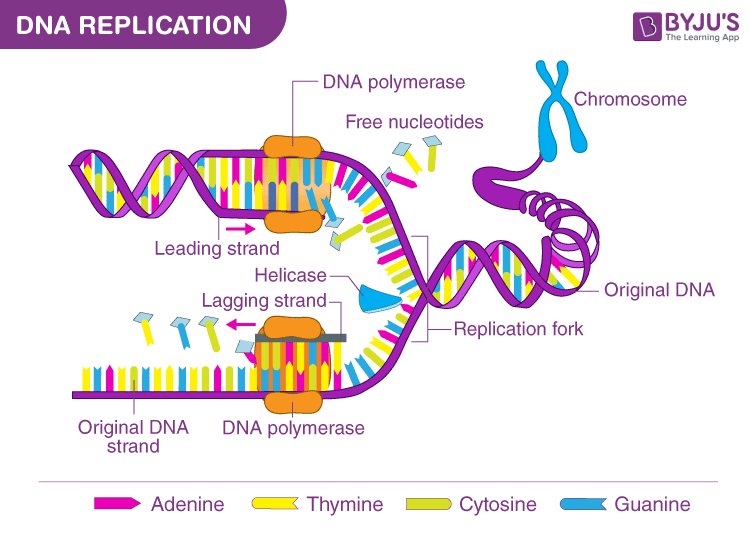We know that DNA is a self-replicating structure and DNA replicates semi-conservatively. However, DNA replication is catalyzed by a set of enzymes. Let’s learn about the DNA replication process and the role of enzymes involved in DNA replication.
DNA Replication
In the process of DNA replication, the DNA makes multiple copies of itself. It is a biological polymerisation, which proceeds in the sequence of initiation, elongation, and termination. It is an enzyme-catalysed reaction. DNA Polymerase is the main enzyme in the replication process.

DNA Replication Process
DNA Replication Steps
Following are the important steps involved in DNA replication:
Initiation
DNA replication demands a high degree of accuracy because even a minute mistake would result in mutations. Thus, replication cannot initiate randomly at any point in DNA.
For the replication to begin there is a particular region called the origin of replication. This is the point where the replication originates. Replication begins with the spotting of this origin followed by the unwinding of the two DNA strands.
Unzipping of DNA strands in their entire length is not feasible due to high energy input. Hence, first, a replication fork is created catalysed by the helicase enzyme, which unzips the DNA strand.
Elongation
As the strands are separated, the polymerase enzymes start synthesising the complementary sequence in each of the strands. The parental strands will act as a template for newly synthesising daughter strands.
It is to be noted that elongation is unidirectional i.e. DNA is always polymerised only in the 5′ to 3′ direction. Therefore, in one strand (the template 3‘→5‘) it is continuous, hence called continuous replication while on the other strand (the template 5‘→3‘) it is discontinuous replication. They occur as fragments called Okazaki fragments. The enzyme called DNA ligase joins them later.

DNA Replication Fork
Termination
Termination of replication occurs in different ways in different organisms. In E.coli like organisms, chromosomes are circular. And this happens when the two replication forks between the two terminals meet each other.
Also Read: DNA Structure
Role of Enzymes in DNA Replication
DNA replication is a highly enzyme-dependent process. There are many enzymes involved in DNA replication, which includes the enzymes, DNA-dependent DNA polymerase, helicase, ligase, etc. Among them, DNA-dependent DNA polymerase is the main enzyme.
DNA-dependent DNA polymerase
It helps in the polymerisation, catalyses and regularises the whole process of DNA replication with the support of other enzymes. Deoxyribonucleoside triphosphates are the substrate as well as the energy provider for the replication process. DNA polymerase is of three types:
DNA Polymerase I
It is a DNA repair enzyme. It is involved in three activities:
- 5′-3′ polymerase activity
- 5′-3′ exonuclease activity
- 3′-5′ exonuclease activity
DNA Polymerase II
It is responsible for primer extension and proofreading.
DNA Polymerase III
It is responsible for in vivo DNA replication.
Helicase
Helicase is the enzyme, which unzips the DNA strands by breaking the hydrogen bonds between them. Thus, it helps in the formation of the replication fork.
Ligase
Ligase is the enzyme which joins together the Okazaki fragments of the discontinuous DNA strands.
Primase
This enzyme helps in the synthesis of RNA primer complementary to the DNA template strand.
Endonucleases
These produce a single-stranded or a double-stranded cut in a DNA molecule.
Single-stranded Binding Proteins
It binds to single-stranded DNA and protects it from forming secondary structures.
Also Read: Difference between Replication and Transcription
DNA Replication Process in Prokaryotes
The DNA replication in prokaryotes takes place in the following place:
- The two strands of DNA unwind at the origin of replication.
- Helicase opens the DNA and replication forks are formed.
- The DNA is coated by the single-strand binding proteins around the replication fork to prevent rewinding of DNA.
- Topoisomerase prevents the supercoiling of DNA.
- RNA primers are synthesised by primase. These primers are complementary to the DNA strand.
- DNA polymerase III starts adding nucleotides at the end of the primers.
- The leading and lagging strands continue to elongate.
- The primers are removed and the gaps are filled with DNA Polymerase I and sealed by ligase.
Also read: Theta Mode of Replication
DNA Replication in Eukaryotes
The DNA replication in eukaryotes is similar to the DNA replication in prokaryotes. However, the initiation process is more complex in eukaryotes than prokaryotes. In eukaryotes, there are multiple origins of replication present. A pre-replication complex is made with other initiator proteins. The process is entirely the same but the enzymes used are different. E.g. in eukaryotes, the polymerisation process is carried out by the enzyme Pol δ, whereas in prokaryotes it is done by DNA Pol III.
Also Read: DNA Packaging

For more information on the DNA replication process in prokaryotes and eukaryotes and the steps involved in DNA replication, keep visiting BYJU’S website or download BYJU’S app for further reference.


easy and simple to understand
Very good understanding
Enlist the components of prokaryotic dna replication machinery and briefly explain function of each of them